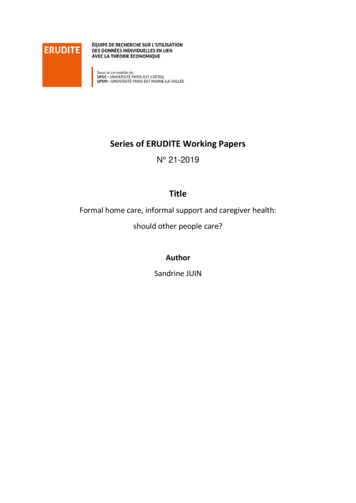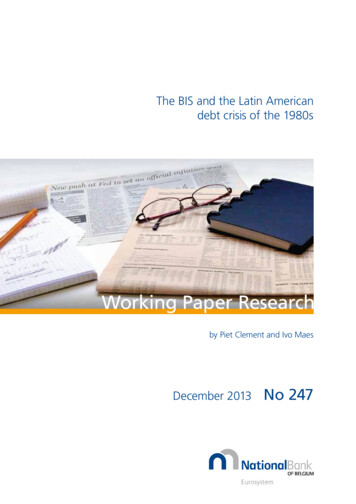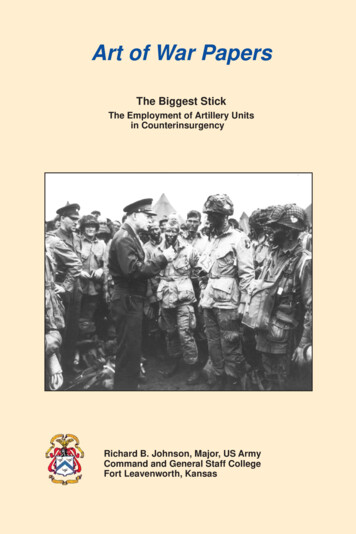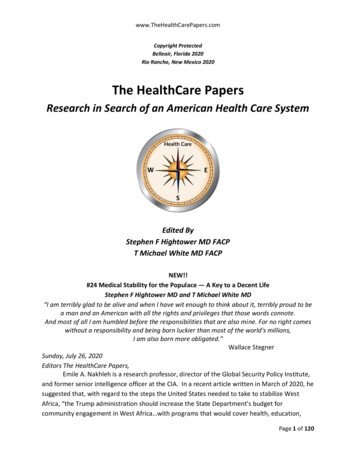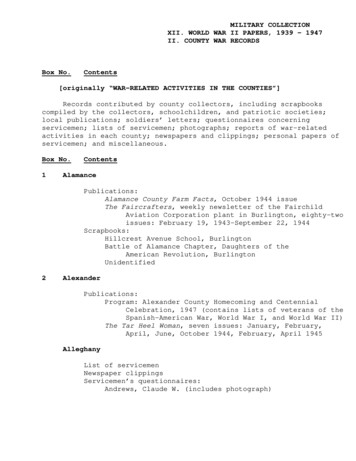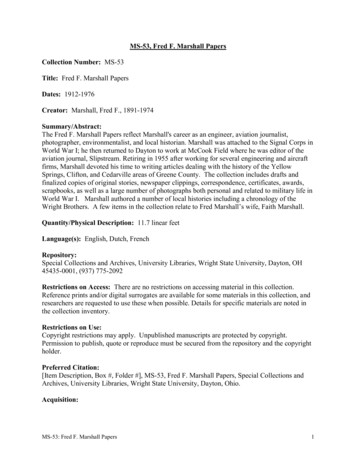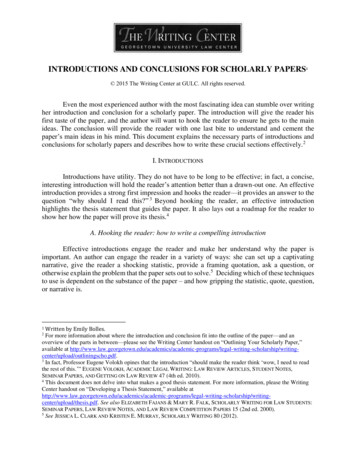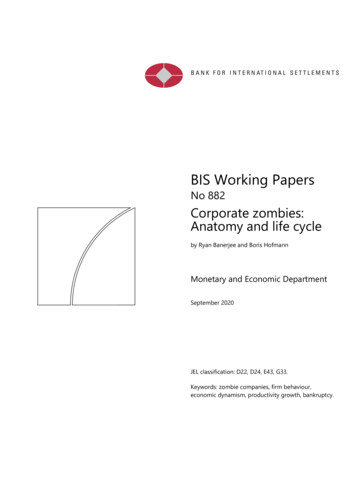
Transcription
BIS Working PapersNo 882Corporate zombies:Anatomy and life cycleby Ryan Banerjee and Boris HofmannMonetary and Economic DepartmentSeptember 2020JEL classification: D22, D24, E43, G33.Keywords: zombie companies, firm behaviour,economic dynamism, productivity growth, bankruptcy.
BIS Working Papers are written by members of the Monetary and EconomicDepartment of the Bank for International Settlements, and from time to time by othereconomists, and are published by the Bank. The papers are on subjects of topicalinterest and are technical in character. The views expressed in them are those of theirauthors and not necessarily the views of the BIS.This publication is available on the BIS website (www.bis.org). Bank for International Settlements 2020. All rights reserved. Brief excerpts may bereproduced or translated provided the source is stated.ISSN 1020-0959 (print)ISSN 1682-7678 (online)
Corporate zombies: Anatomy and life cycle1Ryan Banerjee2Boris Hofmann2Bank for International SettlementsBank for International SettlementsABSTRACTUsing firm-level data on listed non-financial companies in 14 advancedeconomies, we document a rise in the share of zombie firms, defined asunprofitable firms with low stock market valuation, from 4% in the late1980s to 15% in 2017. These zombie firms are smaller, less productive,more leveraged and invest less in physical and intangible capital. Theirperformance deteriorates several years before zombification andremains significantly poorer than that of non-zombie firms insubsequent years. Over time, some 25% of zombie companies exitedthe market, while 60% exited from zombie status. However, recoveredzombies underperform compared to firms that have never been zombiesand they face a high probability of relapsing into zombie status.Keywords: zombie companies, firm behaviour, economic dynamism, productivity growth,bankruptcy.JEL classification: D22, D24, E43, G33.1The views expressed in this paper are those of the authors and do not necessarily reflect thoseof the Bank for International Settlements. The authors thank Claudio Borio, Maria Canelli, StijnClaessens, Sebastian Doerr, Martin Hood, Enisse Kharroubi, Benoît Mojon and KostasTsatsaronis as well as participants in the conference on “The effects of an ultra-low interest rateregime on banks and the economy”, Imperial College, London, 12 December 2019, theConference Board Economists and Strategy Council, 17 March 2020 and a BIS researchmeeting for helpful comments and suggestions.2Banerjee: ryan.banerjee@bis.org; Hofmann: boris.hofmann@bis.org1
1. IntroductionThe rising number of so-called zombie firms, generally defined as firms that areunprofitable but remain in the market rather than exiting through takeover orbankruptcy, has attracted increasing attention in the public debate (Graph 1)). TheCovid-19 pandemic has given further impetus to this debate as the crisis puts severestrains on the corporate sector which governments seek to counteract through largescale support measures (e.g. Financial Times (2020), Lynch (2020)).The literature has so far focused largely on the causes and the consequences ofthe rise of these firms for other firms and for aggregate productivity. But little isknown about the zombies themselves, except that they are commonly found to beless productive than their non-zombie peers.The public debate about zombie firms1Graph ative number of times the words “zombie firms” or “zombie companies” appeared in English, German,French, Italian and Japanese-language newspapers and news magazines as well as in blog or board entries.Sources: Authors’ search in Factiva.In this paper, we aim to fill this gap by exploring the anatomy and life cycle ofzombie companies. Using firm-level data covering 14 advanced economies andspanning three decades, we identify zombie companies based on (i) their persistentlack of profitability, i.e. profits insufficient to cover interest payments on debt(interest coverage ratio below one); and (ii) poor expected future growth potentialrevealed through low equity valuations, i.e. a relatively low ratio of the market valueof firm assets to their book value (relatively low Tobin’s q). The data for theanalysis are from the Worldscope database, providing annual financial statementsof listed companies going back to the 1980s.2
We explore the anatomy of zombie firms by analysing their characteristics andperformance compared with those of non-zombie firms. To this end, we look, interalia, at asset size, capital expenditure, intangible investment, employment,productivity, profitability, leverage, borrowing and equity issuance. As mentionedbefore, while the literature has extensively documented that zombie firms are lessproductive than their profitable peers, there has been very little analysis of otheraspects of their anatomy.To characterise the life cycle of zombie firms, we analyse the development oftheir balance sheet, profit and cash flow accounts in the years before and after theyare first classified as zombies. This analysis sheds light on the questions of howcompanies turn into zombies and what happens to them afterwards. In this vein, wealso assess how many zombie firms eventually died (exited the market) and howmany recovered in a formal sense of not being identified as a zombie anymore byour criterion.Finally, we zoom in on those firms that have managed to recover from zombiestatus. The number of these firms turns out to be rather high which raises thequestion whether the zombie problem is just an illusion. The answer to this questiondepends on the performance of the recovered zombies, whether they become fullynormal firms or whether there are indications of some long-term damage from theirprevious zombification. To assess this point, we calculate the probability ofrecovered zombie firms relapsing into zombie status and compare theirperformance with those firms that have never been zombies.The main results of our analysis are as follows.First, we find that the number of zombie firms has on average risen significantlysince the 1980s across the 14 advanced economies covered by our analysis. Thenumber of zombies rose from about 4% of all listed firms in the mid-1980s to asmany as 15% in 2017. The share of listed corporations’ assets, capital and debt sunkin zombie firms is lower, at around 6%-7%.These estimates however likely understate the number and economic weight ofzombie firms. This is because our analysis focuses on listed companies whichallows us to cover a much longer time span of data and to take into account in ourzombie definition the perceived future growth potential as reflected in equity prices.Our analysis does therefore in particular not cover unlisted small and medium-sizedenterprises (SMEs), which play an important role in many economies. If SMEs aremore susceptible to zombification, then our analysis may understate the number andthe economic weight of zombie firms. Indeed, we find that zombie shares are3
considerably higher in Anglo-Saxon countries, where there is a higher propensityto list on the stock market, in particular for SMEs, than in continental Europeancountries and in Japan. Moreover, we find that amongst listed SMEs, the share ofzombie firms in assets, capital and debt is as high as 30%-40%.Second, we find that zombies’ anatomy differs significantly from that of theirnon-zombie peers. Specifically, we find that, compared with other firms, zombiecompanies are smaller, less productive, and grow less in terms of assets andemployment, while spending less on physical and intangible capital. At the sametime, they are more leveraged. However, their debt shrinks, albeit at a slower pacethan their assets, and they issue more equity compared to other companies. Wefurther find evidence that zombies receive “subsidised” credit as the interest theypay in their debt is not significantly higher than that of non-zombie firms despitetheir lower profitability and greater riskiness.Third, the life cycle of zombie companies is marked by a number of keyfeatures. In the years before they become a zombie, they experience fallingprofitability, productivity, employment and investment. Initially they stay afloat byraising leverage and increasing equity issuance as well as by increasing assetdisposals relative to non-zombie firms. After zombification, their performanceremains significantly poorer than that of non-zombie firms. A zombie firm faces asignificantly higher probability of exiting the market through bankruptcy ortakeover, by about 10 percentage points cumulatively in the following four years(compared to non-zombie firms).Fourth, out of the total number of zombie firms that emerged since the mid1980s, about 25% have exited the market so far (died). Around 60% of zombiefirms have managed to recover, meaning that they were at some point no longeridentified as zombie firms by our criteria. The recovered zombie firms howeverremain weak and fragile. Their productivity, profitability, investment andemployment growth remain well below those of non-zombies. Reflecting this weakperformance, they face a high probability of relapsing into zombie state. By 2017,the probability of becoming a zombie firm in the subsequent year was, at 17%, threetimes higher for a recovered zombie compared to a firm that has never been azombie firm. This relapse probability of recovered zombies has increased more thanthreefold over the past decade.Related literatureOur paper contributes to the growing literature on zombie firms and their widereconomic causes and consequences. The phenomenon was first observed in Japan,4
where the emergence of zombie companies was highlighted as a potentiallyimportant reason for Japan’s lost decade (Caballero et al. (2008)). Adalet McGowanet al. (2017) have documented that the number of zombie firms has increasedsignificantly across the advanced economies in the wake of the Great FinancialCrisis (GFC), while Banerjee and Hofmann (2018) document a longer-lasting trendincrease since the 1980s. These studies find that the main consequence of zombiefirms is reduced economic dynamism and performance. Specifically, zombie firmsare found to be less productive and at the same time create congestion effects forother, more productive firms.With respect to the causes, the literature has identified weak banks as a keyfactor behind the emergence of zombie firms. Caballero et al. (2008) find that therise of zombie firms in Japan in the 1990s was linked to weakly capitalised bankswhich evergreened loans to avoid charge-offs that would have pushed them againstregulatory capital limits. More recently, Storz et al. (2017) and Schivardi et al.(2017) document a similar link between weak banks and zombies in the wake ofthe GFC. Andrews and Petroulakis (2017) highlight the role of bankruptcy laws.They present cross-country evidence suggesting that bankruptcy laws which inhibitcorporate restructuring are associated with a greater prevalence of zombie firms.Press commentaries often point to persistent low interest rates as a key driverof corporate zombification (e.g. Sharma (2019), Taylor (2019), Armstrong (2020)),as they reduce debt service burdens and may induce banks or creditors moregenerally to evergreen loans to non-viable firms. Yet, analytical studies thatformally explore this link are, so far, few. Acharya et al. (2019a) find that euro areabanks used the capital gains on their bond holdings arising from the launch of theECB’s Outright Monetary Transactions (OMT) in 2012 to increase credit supplymainly to low-quality firms with which they had pre-existing lending relationships.Banerjee and Hofmann (2018) present evidence of a positive link between low ratesand the number of zombie companies at the country and at the sectoral level.The remainder of the paper is organised as follows. Section 2 describes howzombie companies are identified in our analysis. Section 3 provides key facts onthe anatomy of zombie firms. In Section 4, we explore the life cycle of zombies,analysing what happened to a firm before and after it became a zombie. Section 5zooms in on the recovered zombie firms. Section 6 concludes.5
2. Identifying zombie firmsWe define a zombie company based on a persistent lack of profitability and lowstock market valuation. The rationale for this definition is that firms which cannotgenerate profits over an extended period and whose stock market valuation suggeststhat they will also not do so in the future should normally exit the market. 3Specifically, we classify a firm as a zombie if over two years (i) its interest ratecoverage ratio (ICR), defined as earnings before interest and taxes (EBIT) overinterest payments, is below one and (ii) the ratio of its assets’ market value toreplacement cost (Tobin’s q) is below the median within its sector. 4 We requiresome persistence in the lack of profitability and low stock market valuations inorder to mitigate the effect of transitory fluctuations of profits and stock prices onthe classification. In this vein, we also require a firm to have an ICR larger than oneor a Tobin’s q above the median also for two consecutive years before it isdeclassified as a zombie firm. In other words, we require also some persistency inperformance improvement before a firm is counted as recovered from zombiestatus. 5Our definition extends profitability-based zombie definitions adopted inprevious studies (e.g. Adalet McGowan et al. (2017), Storz et al. (2017), Schivardiet al. (2017)) by adding the requirement that the firm also has a low future profitpotential in the eyes of investors as reflected in a relatively low Tobin’s q. Thepurpose of this extension is to avoid characterising firms that may make losses3An alternative criterion proposed in the literature is whether a firm is receiving “subsidised”credit. Caballero et al. (2008) and Acharya et al. (2018) identify zombie firms as companiesthat received “subsidise
French, Italian and Japanese-language newspapers and news magazines as well as in blog or board entries. Sources: Authors’ search in Factiva . In this paper, we aim to fill this gap by exploring the anatomy and life cycle of zombie companies. Using firm-level data covering 14 advanced economies and spanning three decades , we identify zombie companies based on (i) their persistent lack of .
